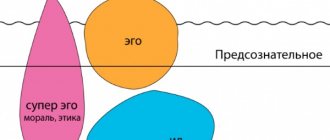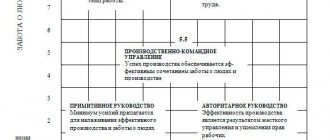Definition of what a team is
The generally accepted definition of a group comes from mathematics. Georg Canton introduced the concept of “set”, on which the “group” rests. A set is a collection of elements that have something in common. Therefore, the concept of “group” or “collective” can be defined as follows: a collection of people who are connected by some interests or social relations.
In psychology, a team is a collection of people who are united by common interests, beliefs, group consciousness, and are connected by common work. This definition is given by V.A. Zhmurov, Doctor of Medical Sciences, psychiatrist and author of the Great Encyclopedia of Psychiatry.
What is the concept of a team in psychology?
The author of the dictionary on conflictology, Davletchina S.B., gives a similar definition of this concept, but with clarifications: a social group of people who are psychologically mature, good relationships have developed between them. This is how people work effectively with each other.
In “Applied aspects of modern psychology” according to N.I. Konyukhov, a team is a community of people. Their personal interactions are significant for joint activities.
A.S. himself Makarenko noted that the concept of a collective is not about issues of friendship or neighborhood, but about dependent responsibility.
Cohesion Tools
If you develop in your employees a desire to help each other, then mutual understanding will appear. After all, team cohesion is a set of human qualities that are developed in a positive way. Basic tools:
- Creation of corporate traditions.
- Spending time together outside of work: active recreation, training, celebrations.
- Systematic meetings at which not only work issues will be discussed.
- Gamification and communication.
- Creative and intellectual team building.
It is required to analyze the individual/psychological characteristics of each team member. Disunity can occur even when people share a common goal.
Cohesion Tools
Kinds
The team can primarily be divided into 2 types: homogeneous and heterogeneous. Groups of the first type are similar in some way. And heterogeneous groups include different strata of society.
What signs can there be of similarities and differences in homogeneous and heterogeneous teams:
- Floor.
- Age.
- Profession.
- Interests.
- The level of education.
A team that is heterogeneous in its composition copes much better with critical tasks that require extraordinary solutions. Often one team is presented with a layer of requirements that do not agree with each other. Therefore, the group must include people with different abilities.
A homogeneous team copes well with current simple tasks that do not require looking at them from different angles. People in such groups understand each other better because they are similar in some way. But for the same reason, the competition in such teams is many times higher. Collectives can be classified not only by homogeneity.
By structure
Groups of people can be divided based on their interests, views, and goals.
Types of teams according to internal structure:
- Political (people unite into communities based on their views on the state and the world as a whole).
- Functional (people are united in a group in which they distribute responsibilities).
- Socio-demographic (people are divided into groups depending on their status, social status, culture, gender, age).
- Socio-psychological (such societies are created on the basis of mutual sympathy of its members).
- Behavioral (people join communities based on their level of activity).
- Motivational (people of the same group have a common goal, which they will achieve faster by working together).
By status
In psychology, a team is official and informal groups. Their main difference is that the official team is bound by official paper, which has legal force. This may be an agreement, charter, or instruction. People are sometimes forced to contact people in their team because they are bound by legal obligations.
The second type of collective is based on an oral agreement and the common interest of people. They have a mutual desire to work with each other. The advantage of an official team is that its members are more disciplined, as they are bound by legal obligations that are written down on paper. For informal teams, it is important to establish clear rules and distribute responsibilities. The advantage of such teams will be a natural desire to work without coercion, as happens in official ones.
For internal communications
Communication in teams can be divided into formal and informal. The first type is when group members interact because of formal distribution. Formal communication is more often established in official teams. An example of an office worker can be given here. He is obliged to work in an official team, as he is bound to it by an employment contract.
When joining a group of people, he is obliged to contact and work with them, since he is formally attached. Informal connections are built spontaneously according to desire and the common goals of people in a team. Formal and informal connections can be connected.
To size
A simple classification divides teams into large and small.
What is the difference between large and small teams:
| Small group of people | Large group of people |
| People know each other well. | Distance of participants from each other |
| Problem solving becomes more difficult due to close emotional connections. Often several people perform the same task. | Everyone performs their duties without being distracted by personal relationships with the participants. |
| Often there is a division into subgroups in which personal, closer relationships are already emerging. | |
| A participant cannot be replaced without compromising performance. Often when one person leaves, the entire team falls apart. Teams of 3 people often force out the third person. | Due to the large number of people, it is difficult to organize self-government. |
By function
In psychology, a team is a group of people that differ in their functions. Classification by function divides teams into 2 types. In the first group, people strive for some common goal and perform certain tasks. The goal of the second group is to establish personal relationships and communication between people.
Such groups can be called “common interests” in another way.
How a cohesive team is formed
Success and a common goal unite the team. Interest is the basis of everything. This is not even about financial gain, but about spiritual development. Every person wants to become a professional in their field. If you put aside disagreements and focus on the process, then soon people will begin to understand each other more and the performance indicator will go up. Main formation factors:
- Selection of strategy and grinding-in stage.
- Identification of the main negative factors.
- Working through conflict situations.
- Modeling cases and conducting experiments.
- Adding a creative touch to training.
When the formation is completed, colleagues will understand the multifunctionality of the team and be inspired by the tasks that are assigned specifically to them.
On a note! When receiving a warning from management, it should motivate, and not lower, the employee’s self-esteem. Every leader should be a psychologist.
Formation
Meaning and role
There are 3 possible outcomes of interaction between a person and a team:
- A person submits to the team. This happens formally or in practice.
- The team is subordinate to the individual. This is where the existing leaders of the group are called into question. There is a high probability of changes in the internal structure of the team. Revision of views.
- Harmony between the team and the individual. Optimal interaction option. But this only happens if the individual shares the views of the entire group of people and pursues the same goals.
In formed large groups, informal connections often arise. They are based on mutual interest. Microgroups are formed. They can influence the team as a whole. They can change its structure, provide motivation to achieve a goal, or change the final goal. Such a group can positively influence the opinion of the team as a whole, and vice versa.
If microgroups become authoritative, they have a positive impact on the personal growth of all its participants. However, if such a subgroup creates conditions for confrontation, then personal growth may slow down. A team, even a large one, can be liquidated due to the influence of an authoritative community of people within it.
The functioning of a team is possible according to 2 unspoken laws:
- Preserving the dignity and social status of each participant.
- All shortcomings are compensated by efficiency, experience, and acquisition of skills.
There are 2 ways to implement these collective laws:
- Positive. This includes active work, discipline, self-management, and division of roles.
- Negative. This includes intrigue, gossip, hypocrisy, and sycophancy.
Team functions
In relation to personal self-development, several functions of the team can be identified that help in this:
- Satisfying the individual's communication needs. A person feels necessary to fulfill a common goal. There is a sense of group belonging.
- The team gives a feeling of security; a group of people creates an atmosphere of support for each participant.
- A person has a calling.
The team helps the individual to look at himself differently. This is a revision of values and interests. New acquaintances appear that help you reach a new level. The psychological connection between the collective and the individual cannot be denied. The team also has its own control system. This system creates structure within the group.
Discipline appears. How is control carried out?
- Motivation.
- Belief.
- Punishment.
- Ban.
The development of the entire team, as well as the individuals within it, directly depends on the leader. His activity is the vector along which other participants move.
"Palace Coups"
Once again the name speaks for itself. During this period, everyone has already gotten used to it and understands what can be expected from other participants, so the time comes when the active struggle for the place of leader intensifies. If there is already a leader in the team, then it is important for him to maintain his position, or if he feels weak, it is better to immediately give way to a stronger candidate. This is a rather difficult period in the life of any team, since separate groups can form here that will impose their opinions on others. There is a big risk that the team will simply fall apart.
Stages of adaptation
There are 5 stages of individual adaptation in a team. They were identified by American psychologists M. Woodcock and D. Francis.
Stages of adaptation of team members:
- Lapping. This stage involves the detachment of the new participant. Sincere motives, desires, feelings are masked. Participants try to find out the interest of other people, but do not listen to each other.
- Close combat . Each of the participants in the process of the team’s activities “rips off the mask” - sincere emotions appear and individuality emerges. Candidates for leadership are visible, roles in the team are gradually distributed. Contradictions and possible conflicts appear.
- Improvement . Team members learn to interact with each other. Roles in the group are established. Leaders have been identified. The structure has been created. The team unites in a common goal. Each participant cares about this goal, not their own. There is an opportunity to improve the performance of the team.
- Result . The fruits of joint activities appear. All participants act as one. There is pride in the result.
- Maturity . A distinctive feature of a mature team is resolving conflicts in a neutral, calm environment. The goals of the entire team completely coincide with the goals of its members.
Personal development
The psychology of people in a team invariably leads to the development of the individual, which takes place when he goes through three stages:
- Adaptation. The new employee masters the norms of the team, the behavioral characteristics and values of its members.
- Personalization. At this stage, the emergence of the personal and the general is inevitable. A person begins to search for ways to express himself.
- Integration. There is an aggravation of the social and individual. The personality begins to show itself. Whether or not the team accepts all the shortcomings and advantages of the new employee.
Contradictions that arise during the integration process are not always successfully resolved. If this happens, then the person becomes maladapted, isolated and expelled from the team. In some cases, he voluntarily leaves it. In this case, the stage of integration is replaced by disintegration.
Psychological theories and schools
Since A.S. Makarenko is considered one of four world-famous specialists who shaped pedagogical thinking back in the 20th century; his theory of teams is considered the most famous. The principles of Makarenko’s pedagogical approach are still partially used today.
His theory is applicable mainly to people with deviation, but it is also suitable for work groups.
According to Makarenko, not any group of people can become a team.
According to his theory, a community goes through stages that create a team:
- First comes the unity of people . The leader of this group of people, the chosen leader, is responsible for this stage. The group at the moment is only formal, people do not know each other, and cannot organize their activities. The task of the organizer (leader) is to unite people. They should have a common goal, motivation to work together, and similar interests. This technique is often used in educational institutions. For example, students enter the first year of university. Groups of people appear who know each other, and it is difficult for them to work in one place. Therefore, at the beginning of the school year, various hiking trips, competitions, and competitions are held. Their goal is to unite a group of people by forming a learning team.
- Leader nomination . Roles are being assigned in the team. Strong people appear ready to lead the crowd. They are chosen as leaders. They are the main source of communication between the leader and the rest of the team. The activist listens to the demands of the leader and conveys them to the team. Thus, the formation of self-government occurs.
- The Dawn of the Collective . The main goal of Makarenko’s educational method is the formation of self-government. At this stage, all roles in the team are distributed. A close-knit group of people has a common goal, so it is beneficial for them to do their job well. Each of the participants makes demands on the others and on themselves, but they are correct. More demands are placed on oneself. You can see that the team was formed according to certain characteristics: unity of opinions, everyone has the right to vote, common experience.
- Now education moves into the process of self-education . Making demands on yourself first becomes a habit. Fulfilling one's duties becomes an internal need for each team member.
According to Makarenko's theory, an important part of the collectivization of a group of people, in his case difficult teenagers, are traditions. Traditions are understood as sustainable forms of life of a group. With their help, relationships develop within a group of people and common interests emerge. The team becomes united. But traditions can transform and change over time, adapting to the collective.
Makarenko’s traditions include:
- Mass events, in preparation for which the team participates. The events evoke general pride and respect.
- Small traditions that are built into everyday life. They contribute to the development of discipline and daily routine. With their help, order is maintained and useful behavioral habits appear. This includes morning exercises for the entire team and joint breaks.
Makarenko believed that in order to unite people into a team, they need to form a common goal. He identified 3 types of goals - close, medium and distant.
What were they:
- A short-term perspective (goal) was set at any point in time, at any stage of the team’s development (stages above). The main thing is that every community member is interested in achieving this goal.
- The average perspective is suitable for teams at their dawn. A group project is selected that involves a common cause.
- Long-term perspective . This type is suitable for a fully established team with an established internal structure. For the work teams of difficult teenagers with whom Makarenko worked, such a goal could be successful education, choosing a professional path in a legal way.
The benefits of teamwork
- Working in a team, you can share your accumulated knowledge and skills, and in return gain new experience.
- A person can perform much more serious and large-scale tasks than he could do alone.
- You can receive some advice from your colleagues and feel their support. Often this applies not only to work activity, but also to everyday life.
- In a team, people learn responsibility. Moreover, here they can be responsible not only for their own work, but also for the work of their colleagues.
- A person can express himself creatively, learn to make general decisions, participate in various discussions and debates, and express his point of view.
- Each member of the team has the right to point out to others their mistakes and blame them if they do not adhere to moral standards.
Methods and stages of formation
In psychology, a team is always a group of people controlled by an organizer. As described above, Makarenko argued that any group goes through stages of formation. His methods are still used in different types of groups.
Communication
In order to establish internal connections in teams of any size, the manager has the responsibility to unite people. This is an important stage that will help avoid a tense situation and reduce the risk of conflicts. A close-knit team is more inclined to self-government, distribution of roles, and selection of a leader.
How to improve communication within a team:
- Joint events for unity, so that people maintain connections outside of work.
- Formation of a common goal.
- Encouraging group work.
Management
Psychological methods of team management include the following points:
- Belief implies argumentation and logical explanation. It is used to remove psychological barriers, eliminate conflicts, and set goals.
- Imitation. Makarenko also said that you need to show your personal successful example to the team members. People will follow such a leader; they will believe in achieving their goals. The behavior pattern of a leader or organizer becomes a source for imitation.
- Involvement. A psychological method that was also used by Makarenko. Each participant is involved in finding solutions, and leaders are jointly selected through voting or discussion. Each participant feels that their opinion is valuable.
- Inducement. A positive way of psychological influence. It was actively used in Soviet times. This may include such forms of encouragement as adding a participant to the Honor Board and presenting certificates. This increases the moral significance of the team member.
- Compulsion. A psychological negative technique that is used in critical situations when the inaction of a participant can lead to damage to the entire team. The participant is forced to perform certain work.
- Requirements. This method can only be used by an authoritative leader who is respected in the team. Otherwise, this method will not work.
- Praise. One of the methods of positive psychological influence. It encourages the participant to do an even better job, a very motivating method. The negative opposite way is condemnation.
The team, which is in its infancy, takes advice well. This is a psychological method when a more experienced participant, leader or manager recommends to an inexperienced comrade what to do in a situation. If advice comes in response to a request, it commands respect from an inexperienced participant. Unsolicited advice can hurt.
Personnel Management
Proof of a manager’s good work is the internal readiness of each member of the team to work for the benefit of the organization and unquestioningly fulfill all the requirements of their superiors. This is the psychology of team management. However, what will achieve such a return from staff? How to ensure that people work to their full potential and bring maximum benefit? The psychology of team management considers achieving such a goal through the use of methods such as employee motivation, as well as their stimulation. The success of the event will depend on:
- comfort in the workplace;
- convenient equipment;
- good (non-conflict) relationships in the team;
- suitable salary;
- opportunities for personal and career growth.
To determine the need for each of the above factors, psychological methods of motivating personnel are used. The need for a particular factor is established by filling out special questionnaires, questionnaires and tests by all employees.









